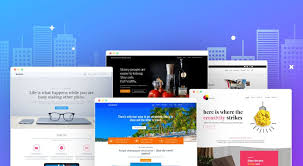
In the digital age, a well-designed website is essential for attracting and retaining visitors. Website page design plays a crucial role in creating a user-friendly experience that encourages engagement and achieves desired outcomes. From layout to color scheme to navigation, every aspect of website page design contributes to the overall success of a site.
One key element of effective website page design is the layout. A clean and organized layout helps users easily find the information they are looking for. Utilizing headers, subheadings, and bullet points can help break up content and make it more digestible for visitors. Additionally, strategically placing calls-to-action throughout the page can guide users toward specific actions, such as making a purchase or signing up for a newsletter.
Another important aspect of website page design is the color scheme. Colors evoke emotions and can influence how users perceive a brand or product. Choosing colors that align with your brand identity and target audience is crucial for creating a cohesive and visually appealing website. Consistency in color usage across pages helps establish brand recognition and reinforces your brand message.
Navigation is also a critical component of website page design. A clear and intuitive navigation menu helps users easily move through your site and find what they are looking for. Including breadcrumbs, search bars, and sitemaps can further enhance navigation and improve the overall user experience.
Incorporating multimedia elements such as images, videos, and infographics can make website pages more engaging and interactive. Visual content not only captures users’ attention but also helps convey information more effectively than text alone. However, it’s important to optimize multimedia elements for fast loading times to prevent user frustration.
Responsive design is another essential consideration in website page design. With the increasing use of mobile devices to access websites, ensuring that your pages are responsive across all screen sizes is crucial for providing a seamless user experience. Responsive design adapts the layout of your site to fit different screen sizes, ensuring that content remains accessible and visually appealing on any device.
In conclusion, effective website page design encompasses various elements that work together to create an engaging user experience. By focusing on layout, color scheme, navigation, multimedia elements, responsive design, and other key aspects of web design, you can create a visually appealing and user-friendly website that captivates visitors and drives desired actions.
Top 5 Tips for Effective Website Page Design
- Keep the design simple and uncluttered for easy navigation.
- Use a consistent color scheme and font style throughout the website.
- Ensure that the website is mobile-responsive for optimal viewing on all devices.
- Include clear call-to-action buttons to guide users on what to do next.
- Optimize images and videos for fast loading speed to improve user experience.
Keep the design simple and uncluttered for easy navigation.
Keeping the design of your website simple and uncluttered is a crucial tip for enhancing navigation and improving user experience. By minimizing distractions and focusing on essential elements, such as clear navigation menus and prominent calls-to-action, you can help users easily find the information they are looking for. A clean and uncluttered design not only makes it easier for visitors to navigate your site but also creates a more visually appealing and professional-looking website. Remember, simplicity is key when it comes to guiding users through your site efficiently and effectively.
Use a consistent color scheme and font style throughout the website.
Using a consistent color scheme and font style throughout a website is crucial for creating a cohesive and visually appealing user experience. Consistency in colors and fonts helps establish brand identity, reinforces brand recognition, and enhances overall design aesthetics. By maintaining uniformity across all web pages, visitors can easily navigate the site, recognize key elements, and build trust in the brand. A harmonious color scheme and font style contribute to a professional and polished look, making the website more engaging and memorable for users.
Ensure that the website is mobile-responsive for optimal viewing on all devices.
Ensuring that your website is mobile-responsive is crucial for providing an optimal viewing experience on all devices. With the increasing use of smartphones and tablets to access websites, it’s essential that your site adapts seamlessly to different screen sizes and resolutions. A mobile-responsive design not only improves user experience but also boosts your site’s visibility in search engine rankings. By prioritizing mobile responsiveness in your website page design, you can reach a wider audience and engage users across various devices effectively.
Include clear call-to-action buttons to guide users on what to do next.
Including clear call-to-action buttons on your website page is a crucial tip in web design. These buttons serve as signposts that guide users on what action to take next, whether it’s making a purchase, signing up for a newsletter, or contacting your business. By using compelling language and placing the call-to-action buttons strategically throughout the page, you can effectively prompt users to engage with your content and ultimately achieve your desired goals. Clear and prominent call-to-action buttons help streamline the user experience and make it easier for visitors to navigate your site and take the desired actions.
Optimize images and videos for fast loading speed to improve user experience.
Optimizing images and videos for fast loading speed is a crucial tip in website page design to enhance user experience. By reducing file sizes, choosing the right file formats, and implementing lazy loading techniques, you can ensure that visual content loads quickly and smoothly for visitors. Fast-loading images and videos not only improve page load times but also prevent user frustration and abandonment. Prioritizing speed optimization for multimedia elements helps create a seamless browsing experience that keeps users engaged and encourages them to explore your website further.
